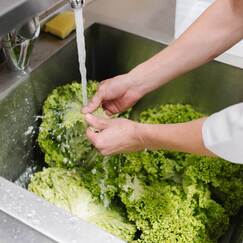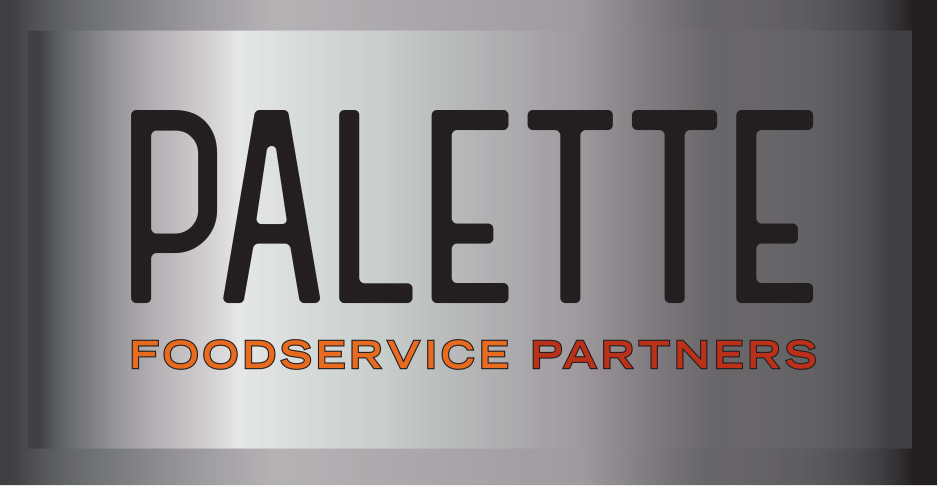 Despite the rise in real-time, tech-based controls designed to help businesses monitor foodborne illness risks, outbreaks continue to be an issue for foodservice operations. The CDC recorded 519 norovirus outbreaks between August 2023 and January of this year, a sharp rise from the previous year’s numbers, and Salmonella has impacted people across 32 states in recent months. On top of food safety technology that helps foodservice operations monitor protocols and stay alert to problems, old-fashioned food safety practices are just as important. A Food Safety Tech report says this should include thorough, frequent handwashing; proper hand hygiene prior to handling food; and the use of alcohol-based sanitizer as an added precaution – not a substitute – for handwashing. It’s also important to clean and sanitize high-touch surfaces and equipment regularly – and wash and sanitize produce to eliminate contaminants (the recent Salmonella outbreak was linked to cantaloupe and pre-cut fruit products). The report also advises careful handling and proper cooking of seafood, particularly shellfish, and having an employee policy with clear guidelines for managing staff illness, especially regarding when it’s important to avoid handling food or reporting to work.  Sixty percent of worker’s compensation claims are the result of slips, falls, strains and burns at work, according to the National Council on Compensation Insurance. Between 2020 and 2021, the council found that among the costliest lost-time claims by cause of injury were burns ($52,161 for each claim) and falls or slips ($49,971 for each claim). Unfortunately, these risks are common in restaurants – and tasks such as managing cooking oil increase risks of both burns and slips or falls. If you’re experiencing losses in these areas, it’s worth conducting an audit of the risks that tend to generate worker’s compensation claims. Addressing them can deliver a ripple of benefits. For example, if you’re still managing your cooking oil using manual processes, automating it can improve staff safety, labor efficiency and food quality, as well as reduce your overall oil usage and expense, according to a new report from Restaurant Dive. The tech-based monitoring that accompanies automated oil management can also help you keep tighter control on your oil quality and costs by alerting you when there are problems.  As the weather warms up and your guests are craving the rainbow of local, farm-fresh vegetables you may be offering on your menu, it’s important to take a step back and think about food safety. Vegetables can come across as inherently fresh, clean and appealing to eat right off the vine – especially if they carry labels like “organic” or “sustainably grown,” for example. But that’s a misconception. As food safety professional Doug Powell said in a report from US Foods, “Fresh produce is the biggest source of foodborne illness in the U.S. and North America, and it has been for at least a decade.” Because fresh produce has been responsible for tens of thousands of foodborne illnesses over the past 10 years, it pays to scrutinize the sources of the produce you buy, as well as the food safety practices your suppliers use. That means tracing potential contaminants right down into the soil in which these foods are grown. For example, Powell advises collecting information about the water farmers use for irrigation, if and how they amend their soil to suit crops, and how well they enforce hand-washing practices.  If your business is struggling with hiring and retaining staff, it may also be struggling to carry out food safety training – or to review any processes that don’t directly support your compliance with local and state regulations. But unfortunately, a restaurant may suffer for this in the long term if employees are injured on the job or if the business faces a steep insurance claim that could have been prevented by having a strong safety culture. Your restaurant’s commitment to safety should be so woven through its fabric that senior leaders talk about it regularly and every new hire is aware of your approach before they even start their job. To make it easier to share safety knowledge and encourage retention, automate what you can – through the use of video training, gamification and digital tools that guide staff through preparation tasks that protect safety. Then take steps to broaden the knowledge of your team through regular cross-training to help fill gaps. Give your more senior staff mentoring roles with newer staff. Above all, explain the why behind why you perform certain safety practices so that tasks are less likely to fall through the cracks as you manage the other demands of your business.  If your kitchen staff is smaller than it once was – or it lacks the culinary skill to prepare your menu items from scratch – you’re likely weaving more prepared foods into your inventory right now. But beyond saving labor hours, these ingredients are likely to deliver food safety benefits too. Pre-cooked ingredients – like cooked, smoked beef that simply needs reheating, for example – can help a young team sidestep concerns about the safe preparation of a protein. Other speed-scratch items can help you prevent cuts and burns. There is a wide and growing array of these ingredients available at various stages of preparation, whether you need items pre-cut, pre-marinated, or pre-cooked. As Stacey Kincaid, vice president of product development and innovation for US Foods, told Restaurant Business recently, “Labor-saving products are in high demand, as are versatile products that can be used across the menu. So, once you train a team member on one product or ingredient, you don’t have to retrain.” That means you’re able to redistribute your training hours in new ways – like by cross-training people on a range of tasks that will support your team during a shift when you’re often shorthanded, training a new employee who needs one-on-one support, or providing in-depth safety training to the team.  Meet your need for clean, plentiful ice The warmer months are coming – and as various regions of the country experience sweltering temperatures more often, guests will be craving icy beverages and cold foods from your business. You will need a reliable supply of ice to ensure you can meet the demands of warm weather. Now is a good time to make sure you’re ready to do so safely. First, assess how well your ice machine will be able to handle your anticipated needs for ice in the months ahead. What does your historical guest data (as well as any predictive data you can access) tell you about your likely needs for chilled beverages and food? If you have an older ice machine, how can you accommodate any of its limitations through pre-emptive service or revised workflows during a shift? While bacteria and mold can grow in an ice machine regardless of the temperature outside, heavier use of these machines in warm weather requires more frequent cleaning and sanitization – something that may not be happening as often as it should. Your employee training procedures can ensure this task stays on track, while also helping your staff use your ice machine in ways that limit the risk of cross-contamination.  How tech can take safety, quality and compliance concerns off your plate If you’re managing a continuous cycle of having to do more with less – like juggling more work across a smaller crew, for example, or having to conduct more onboarding training with fewer longtime staff on your roster – it can be easy for your food safety and quality to slip through the cracks. Fortunately, tech tools can help you ensure you’re upholding key standards regardless of what’s happening and which employees are staffed during a shift. As Restaurant Technology News reported recently, tech-driven support can include everything from prompts to wash hands during busy periods to reminders about completing compliance tasks across multiple locations. Looking at your operation, where are manual processes still in use? Where do you see your standards slipping – or see potential for that to happen? Looking externally, do all of your suppliers share your commitment to safety and have mechanisms in place to protect it, or is there room to make changes for the better? When automated tools are in place, you’re able to manage business more effectively with fewer people and you also stand to make your employees’ jobs a little easier, which can help with morale and retention.  When the U.S. Centers for Disease Control (CDC) led a study investigating the various factors that contribute to the cross-contamination of food in restaurants, they found more frequent cases of contamination in businesses that were lacking food safety training and certification, as well as those without handwashing policies. Contamination risks were present in restaurants that didn’t require manager certification or train workers in food safety, for example. As for handwashing, the risk for contamination was greatest in restaurants that didn’t have policies detailing where, when and how often to wash hands, or on the need to minimize bare-hand contact with ready-to-eat foods. Unfortunately, 60 percent of the foodborne illness outbreaks reported to the CDC each year connect back to restaurants, so it’s worth zeroing in on these areas if improving food safety is on your list of priorities this year. Having a staff discussion about handwashing is something a restaurant manager can do right away to help lower a restaurant’s risks – particularly at a time when seasonal viruses are common.  Want to decrease your risk of food poisoning for your guests? One important step you can take is offering paid sick leave. In a recent study by the Centers for Disease Control and Prevention, the agency tracked 800 illness outbreaks linked to 875 foodservice establishments over a two-year period and found that 40 percent of outbreaks with at least one reported factor were associated with food contaminated by an ill or infectious worker – or, in other words, a worker who should have been out sick but was working. Offering paid sick leave can be a difficult possibility to consider at a time when foodservice operations are short-staffed as it is, but it’s preferable when you consider the broader picture: You’re spreading infection to guests and other employees, and potentially causing financial and reputational damage to the brand. In one telling example from a few years ago, a national restaurant brand reported losing $1 billion in value over a five-day period after just one employee came to work with norovirus and the store employing the person did not follow its protocols about staff illness. Yet even when the risk-benefit analysis demonstrates the damage that can result when an employee comes to work sick, many studies have shown that the majority of sick employees of foodservice businesses still report to work – often because they can’t afford to lose pay or feel pressured by their employer to do so. Offering some paid time off for sick leave can serve as a safety net for both your staff and your business.  Enhance your risk management culture Taking a more proactive approach to risk management in your business can save you significant money and time in the long run – helping you avoid costly insurance claims, repeat safety inspections, business interruptions and other drains on resources that you’d rather direct to improving your overall operation. Could risk management be woven into your culture more tightly this year? It can help to look across your operation to assess risks as diverse as your potential for equipment problems, food safety concerns and cybersecurity vulnerabilities. Connect your risks to daily tasks that help you identify and respond to problems. Assess where staff training is needed to reinforce the actions your business needs to take to manage these issues day to day. Then make it possible to track these actions – by tying each task to a person on staff and using automated dashboards and checklists that make it easy to monitor when jobs are completed and missed. To manage evolving risks to cybersecurity, conduct regular testing with the help of your vendor, limit system access to key personnel, and ensure you’re using protections such as multifactor authentication and encryption as additional data safeguards. |
subscribe to our newsletterArchives
April 2024
Categories
All
|



 RSS Feed
RSS Feed